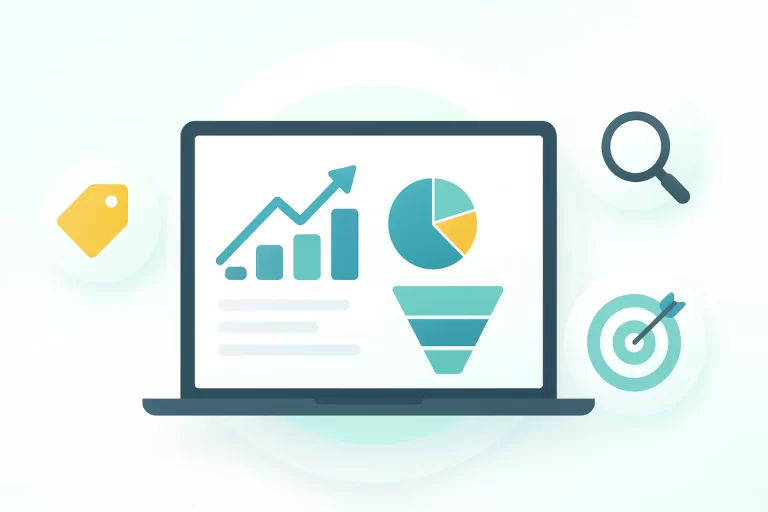A sustainable website prioritises performance, efficiency, and long-term value. It uses fewer resources, runs smoothly under pressure, and minimises environmental impact across its lifecycle. Thoughtful design and development choices reduce page weight, improve load speed, and support a stable user experience on every device and connection.
Digital services now form a measurable part of an organisation’s carbon and energy footprint. Websites sit at the centre of brand visibility, customer interaction, and commercial performance. Poor performance leads to higher bounce rates, frustrated users, and missed revenue. A streamlined website supports faster journeys and measurable business outcomes.
Discover how performance-led builds drive business outcomes in our recent Projects.
The Business Benefits of a Truly Sustainable Website
A sustainable website supports growth by working efficiently for both users and the business behind it.
Faster Load Speeds That Improve Conversion and Visibility
A sustainable website loads quickly because it avoids unnecessary weight. Smaller page sizes use less data when moving between the server and device. This reduces strain on networks and helps maintain consistent performance.
It also creates smoother journeys when people:
- Browse products
- Read content
- Complete forms
The best part is that faster sites generally have lower bounce rates and higher engagement. This helps enhance search visibility and boosts conversion performance across the board.
Reduced Costs With Leaner, More Efficient Infrastructure
Efficient websites use less processing power and rely on hosting that manages energy more carefully. Just take a look at government strategies, such as the Greening Government ICT and Digital Services Strategy. There's a clear need to reduce carbon and cost across digital services, including data centres and hosting. Businesses save money in the long run by opting for greener hosting and reducing processing demands. Clean, organised code also reduces the maintenance effort over the site's life. It frees teams up to focus on improvements that support growth.
Build Brand Trust with Customers Who Value Sustainability
Sustainable websites also play a part in how organisations demonstrate responsibility. Public reports and policy discussions are now recognising how ICT impacts emissions and net-zero goals. When a site runs efficiently, loads predictably, and is easy to use, it reflects well on the brand. For starters, visitors experience fewer barriers and gain information more quickly. Yet, this has an added benefit in that it builds confidence in the organisation’s ability to deliver a reliable service.
What Actually Makes a Website Sustainable Today
Decisions shape a sustainable website long before launch. Every design choice, line of code, asset and hosting decision affects how much energy the site uses and how well it performs for users. A planned approach leads to a website that is stable, adaptable, and cost-effective over its lifecycle.
Cleaner, Leaner Code That Reduces Energy Use
Websites operate more efficiently when developers remove unnecessary scripts and avoid heavy frameworks that provide little value. Cleaner code reduces processing requirements, supports better performance, and shortens the time it takes for pages to render on any device. This approach is evident in our web development projects.
Optimised Media That Loads Faster & Uses Less Data
Media files are often the largest contributors to page weight. Using modern formats and compressing assets makes pages load quicker. They also use less data while maintaining clarity, which is vital for sustainability. Guidance on digital carbon footprints suggests that intensive data activities lead to higher energy consumption in data centres and networks. Optimised media enhances daily journeys for users on mobile networks and slower connections. It lowers delays and promotes smoother interactions.
Hosting Powered by Lower-Carbon Infrastructure
Hosting has a continual energy demand even when traffic is low. Choosing a provider powered by renewable or lower-carbon energy reduces the environmental impact of digital operations while supporting resilience and transparency. Hosting aligned with sustainability goals supports long-term reliability and easier reporting. For more on hosting options that prioritise resilience and efficiency, visit our Web Hosting page.
Accessible, Ethical Design Helps Every User Succeed
Sustainability also includes how easily people can use a website. Clear layouts, readable typography and inclusive interaction patterns. These are just some of the things that help more users complete tasks with fewer steps. UK accessibility rules state that public sector websites must adhere to the Web Content Accessibility Guidelines (WCAG) standards. This expectation is also spreading to other sectors, so why shouldn’t businesses follow suit?
Long-Term Maintenance That Extends Site Lifespan
A sustainable website should be straightforward to maintain and evolve. Modular builds, organised content structures, and reusable components reduce the need for complete rebuilds. Government guidance on sustainability reporting encourages organisations to consider their long-term resource use and lifecycle impact. This also applies to digital services and infrastructure. Our Web Support services are built on this principle. They ensure that performance, security, and content stay aligned over time.
Step-by-Step Guide on How to Build a More Sustainable Website
A phased approach enables measurable improvements without major disruption.
Step 1: Audit Your Current Performance
Identify pages with heavy media, slow load speeds, or high bounce rates. Reviewing Core Web Vitals page weight, and hosting efficiency highlights the areas with the highest impact
Step 2: Streamline Design, Code & Content
Simplify navigation and layouts to reduce unnecessary elements. Removing redundant scripts, visuals, and outdated content reduces data transfer and improves clarity.
Step 3: Switch to Hosting with A Lower Carbon Impact
Choose hosting that discloses energy sources and aligns with sustainability commitments. Pairing efficient design with greener infrastructure creates performance stability and delivers an easier case for long-term value.
Build a Faster, Greener, Higher-Performing Website with b4b
Sustainable websites create cleaner, more accessible, and more reliable user journeys. They improve search visibility, reduce overheads, and provide a digital foundation that scales with business needs.
At b4b, we design and build websites with sustainability, user experience and long-term value in mind. Our teams combine strategy, design, development, UX, and support. We create sites that are easy to run, simple to maintain, and ready for future needs. For further insight into how digital strategy is evolving, visit our News section for updates and guidance from our team.
Call 01202 684400 or arrange a consultation and start supporting sustainable growth for your business.











